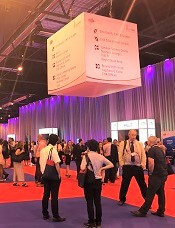User login
An all-oral treatment regimen can produce deep and durable responses in patients with newly diagnosed multiple myeloma (MM), according to a speaker at the 22nd Congress of the European Hematology Association (EHA).
In a phase 1/2 study, patients with newly diagnosed MM received treatment with ixazomib, lenalidomide, and dexamethasone for up to 12 cycles, followed by maintenance with ixazomib alone.
The overall response rate was 88% for the entire cohort and 80% among patients who did not proceed to transplant.
The median progression-free survival was 35.4 months in the entire cohort and 29.4 months in patients who did not proceed to transplant.
Most patients did not complete all 12 cycles of induction, but 38% proceeded to maintenance, and 12% remain on study treatment at a median follow-up of 56 months.
Shaji Kumar, MD, of the Mayo Clinic in Rochester, Minnesota, presented these results at the EHA Congress as abstract S408. The research was sponsored by Millennium Pharmaceuticals, Inc., a subsidiary of Takeda Pharmaceutical Company Limited.
Patients
The trial included 65 patients. Their median age was 66 (range, 34-86), and 55% were male. Eight percent of patients had high-risk cytogenetics.
ECOG performance status was 0 for 43% of patients, 1 for 52%, and 2 for 5%. ISS stage was 1 for 43% of patients, 2 for 43%, and 3 for 14%.
Treatment
Patients received ixazomib (1.68 - 3.95 mg/m2 in phase 1 and 4.0 mg in phase 2 on days 1, 8, and 15) plus lenalidomide (25 mg on days 1-21), and dexamethasone (40 mg on days 1, 8, 15, and 22) for up to twelve, 28-day cycles. Patients could then receive ixazomib maintenance until disease progression or unacceptable toxicity.
Twenty-three patients (35%) discontinued induction to undergo hematopoietic stem cell transplant (HSCT).
Thirty-seven patients discontinued study treatment for other reasons—17 of them during induction. Twenty-one patients discontinued due to progressive disease, 9 due to adverse events (AEs), 5 due to patient withdrawal, 1 due to unsatisfactory response, and 1 due to other reasons.
Twenty-five patients completed induction and went on to receive ixazomib maintenance. Five patients remain on study treatment.
Safety
Seventy-eight percent of patients had a grade 3 or higher AE, 46% had a serious AE, 57% had an AE leading to dose reduction, and 15% had an AE leading to discontinuation of any of the study drugs. There were 2 on-study deaths.
The most common grade 3 or higher AEs were neutropenia, thrombocytopenia, diarrhea, back pain, vomiting, nausea, peripheral neuropathy, and rashes/eruptions/exanthems.
Efficacy
The overall response rate was 88% for the entire cohort and 80% among patients who did not go on to receive HSCT.
The complete response (CR) rates were 23% and 32%, respectively. Thirty four percent and 32%, respectively, had a very good partial response (VGPR). And 30% and 17%, respectively, had a partial response (PR).
Thirty-two percent of patients who received maintenance (n=8) had an improvement in their response during the maintenance phase. Two patients went from a VGPR to a stringent CR, 3 went from a VGPR to a CR, 2 went from a VGPR to a near CR, and 1 went from a PR to a VGPR.
Sixteen patients were evaluated for minimal residual disease (MRD). Of the patients with a stringent CR/CR, 89% (8/9) were MRD-negative.
The median progression-free survival was 35.4 months in the entire cohort and 29.4 months in patients who did not proceed to HSCT. The 4-year overall survival rate was 84% and 82%, respectively.
“Long-term follow-up, a median follow-up of 56 months, with the combination of ixazomib, lenalidomide, and dexamethasone demonstrates that this is an efficacious regimen for newly diagnosed myeloma patients, with excellent tolerability, and something that can be maintained for a long period of time,” Dr Kumar said. “These results form the basis for an ongoing phase 3 program.” ![]()
An all-oral treatment regimen can produce deep and durable responses in patients with newly diagnosed multiple myeloma (MM), according to a speaker at the 22nd Congress of the European Hematology Association (EHA).
In a phase 1/2 study, patients with newly diagnosed MM received treatment with ixazomib, lenalidomide, and dexamethasone for up to 12 cycles, followed by maintenance with ixazomib alone.
The overall response rate was 88% for the entire cohort and 80% among patients who did not proceed to transplant.
The median progression-free survival was 35.4 months in the entire cohort and 29.4 months in patients who did not proceed to transplant.
Most patients did not complete all 12 cycles of induction, but 38% proceeded to maintenance, and 12% remain on study treatment at a median follow-up of 56 months.
Shaji Kumar, MD, of the Mayo Clinic in Rochester, Minnesota, presented these results at the EHA Congress as abstract S408. The research was sponsored by Millennium Pharmaceuticals, Inc., a subsidiary of Takeda Pharmaceutical Company Limited.
Patients
The trial included 65 patients. Their median age was 66 (range, 34-86), and 55% were male. Eight percent of patients had high-risk cytogenetics.
ECOG performance status was 0 for 43% of patients, 1 for 52%, and 2 for 5%. ISS stage was 1 for 43% of patients, 2 for 43%, and 3 for 14%.
Treatment
Patients received ixazomib (1.68 - 3.95 mg/m2 in phase 1 and 4.0 mg in phase 2 on days 1, 8, and 15) plus lenalidomide (25 mg on days 1-21), and dexamethasone (40 mg on days 1, 8, 15, and 22) for up to twelve, 28-day cycles. Patients could then receive ixazomib maintenance until disease progression or unacceptable toxicity.
Twenty-three patients (35%) discontinued induction to undergo hematopoietic stem cell transplant (HSCT).
Thirty-seven patients discontinued study treatment for other reasons—17 of them during induction. Twenty-one patients discontinued due to progressive disease, 9 due to adverse events (AEs), 5 due to patient withdrawal, 1 due to unsatisfactory response, and 1 due to other reasons.
Twenty-five patients completed induction and went on to receive ixazomib maintenance. Five patients remain on study treatment.
Safety
Seventy-eight percent of patients had a grade 3 or higher AE, 46% had a serious AE, 57% had an AE leading to dose reduction, and 15% had an AE leading to discontinuation of any of the study drugs. There were 2 on-study deaths.
The most common grade 3 or higher AEs were neutropenia, thrombocytopenia, diarrhea, back pain, vomiting, nausea, peripheral neuropathy, and rashes/eruptions/exanthems.
Efficacy
The overall response rate was 88% for the entire cohort and 80% among patients who did not go on to receive HSCT.
The complete response (CR) rates were 23% and 32%, respectively. Thirty four percent and 32%, respectively, had a very good partial response (VGPR). And 30% and 17%, respectively, had a partial response (PR).
Thirty-two percent of patients who received maintenance (n=8) had an improvement in their response during the maintenance phase. Two patients went from a VGPR to a stringent CR, 3 went from a VGPR to a CR, 2 went from a VGPR to a near CR, and 1 went from a PR to a VGPR.
Sixteen patients were evaluated for minimal residual disease (MRD). Of the patients with a stringent CR/CR, 89% (8/9) were MRD-negative.
The median progression-free survival was 35.4 months in the entire cohort and 29.4 months in patients who did not proceed to HSCT. The 4-year overall survival rate was 84% and 82%, respectively.
“Long-term follow-up, a median follow-up of 56 months, with the combination of ixazomib, lenalidomide, and dexamethasone demonstrates that this is an efficacious regimen for newly diagnosed myeloma patients, with excellent tolerability, and something that can be maintained for a long period of time,” Dr Kumar said. “These results form the basis for an ongoing phase 3 program.” ![]()
An all-oral treatment regimen can produce deep and durable responses in patients with newly diagnosed multiple myeloma (MM), according to a speaker at the 22nd Congress of the European Hematology Association (EHA).
In a phase 1/2 study, patients with newly diagnosed MM received treatment with ixazomib, lenalidomide, and dexamethasone for up to 12 cycles, followed by maintenance with ixazomib alone.
The overall response rate was 88% for the entire cohort and 80% among patients who did not proceed to transplant.
The median progression-free survival was 35.4 months in the entire cohort and 29.4 months in patients who did not proceed to transplant.
Most patients did not complete all 12 cycles of induction, but 38% proceeded to maintenance, and 12% remain on study treatment at a median follow-up of 56 months.
Shaji Kumar, MD, of the Mayo Clinic in Rochester, Minnesota, presented these results at the EHA Congress as abstract S408. The research was sponsored by Millennium Pharmaceuticals, Inc., a subsidiary of Takeda Pharmaceutical Company Limited.
Patients
The trial included 65 patients. Their median age was 66 (range, 34-86), and 55% were male. Eight percent of patients had high-risk cytogenetics.
ECOG performance status was 0 for 43% of patients, 1 for 52%, and 2 for 5%. ISS stage was 1 for 43% of patients, 2 for 43%, and 3 for 14%.
Treatment
Patients received ixazomib (1.68 - 3.95 mg/m2 in phase 1 and 4.0 mg in phase 2 on days 1, 8, and 15) plus lenalidomide (25 mg on days 1-21), and dexamethasone (40 mg on days 1, 8, 15, and 22) for up to twelve, 28-day cycles. Patients could then receive ixazomib maintenance until disease progression or unacceptable toxicity.
Twenty-three patients (35%) discontinued induction to undergo hematopoietic stem cell transplant (HSCT).
Thirty-seven patients discontinued study treatment for other reasons—17 of them during induction. Twenty-one patients discontinued due to progressive disease, 9 due to adverse events (AEs), 5 due to patient withdrawal, 1 due to unsatisfactory response, and 1 due to other reasons.
Twenty-five patients completed induction and went on to receive ixazomib maintenance. Five patients remain on study treatment.
Safety
Seventy-eight percent of patients had a grade 3 or higher AE, 46% had a serious AE, 57% had an AE leading to dose reduction, and 15% had an AE leading to discontinuation of any of the study drugs. There were 2 on-study deaths.
The most common grade 3 or higher AEs were neutropenia, thrombocytopenia, diarrhea, back pain, vomiting, nausea, peripheral neuropathy, and rashes/eruptions/exanthems.
Efficacy
The overall response rate was 88% for the entire cohort and 80% among patients who did not go on to receive HSCT.
The complete response (CR) rates were 23% and 32%, respectively. Thirty four percent and 32%, respectively, had a very good partial response (VGPR). And 30% and 17%, respectively, had a partial response (PR).
Thirty-two percent of patients who received maintenance (n=8) had an improvement in their response during the maintenance phase. Two patients went from a VGPR to a stringent CR, 3 went from a VGPR to a CR, 2 went from a VGPR to a near CR, and 1 went from a PR to a VGPR.
Sixteen patients were evaluated for minimal residual disease (MRD). Of the patients with a stringent CR/CR, 89% (8/9) were MRD-negative.
The median progression-free survival was 35.4 months in the entire cohort and 29.4 months in patients who did not proceed to HSCT. The 4-year overall survival rate was 84% and 82%, respectively.
“Long-term follow-up, a median follow-up of 56 months, with the combination of ixazomib, lenalidomide, and dexamethasone demonstrates that this is an efficacious regimen for newly diagnosed myeloma patients, with excellent tolerability, and something that can be maintained for a long period of time,” Dr Kumar said. “These results form the basis for an ongoing phase 3 program.” ![]()

